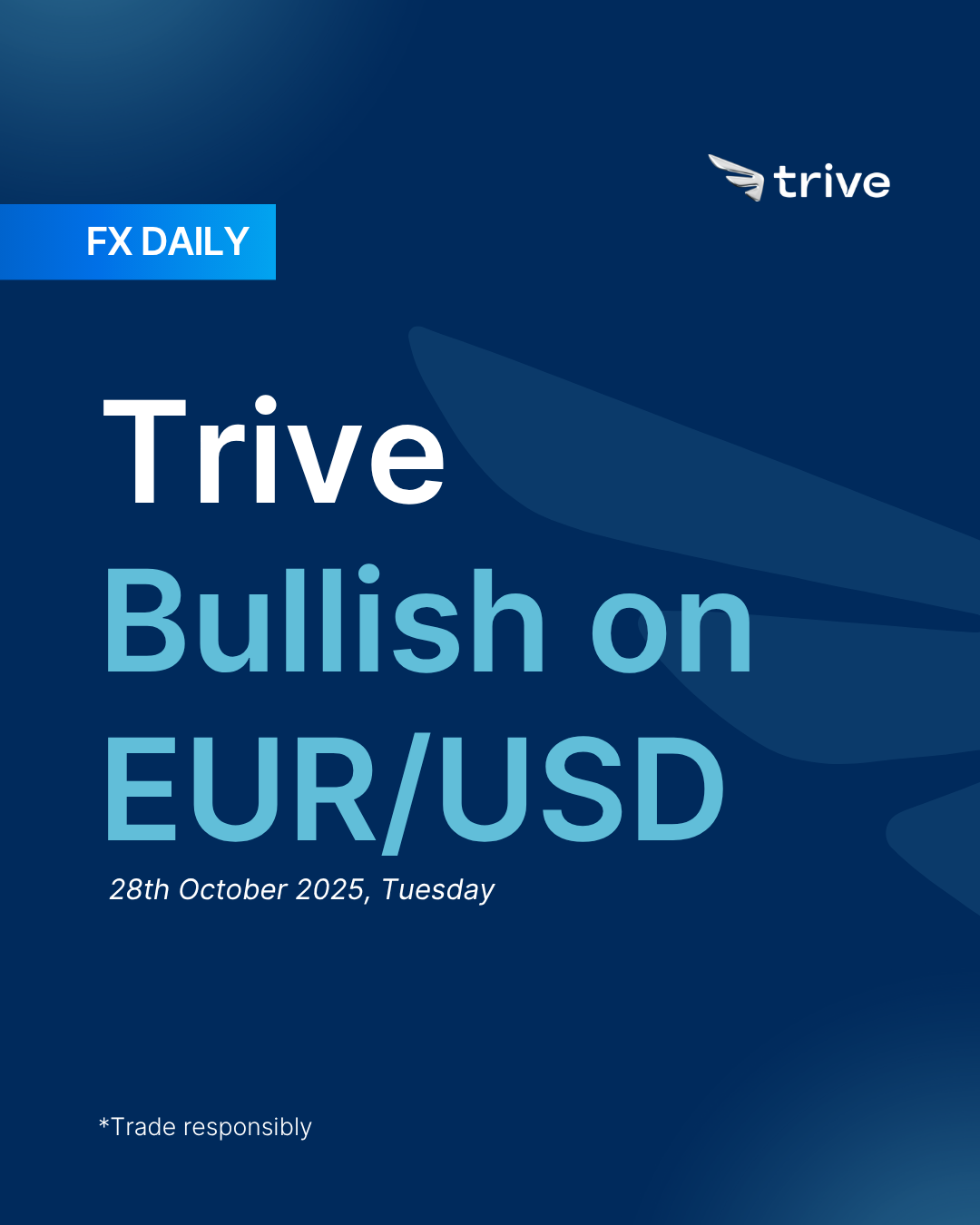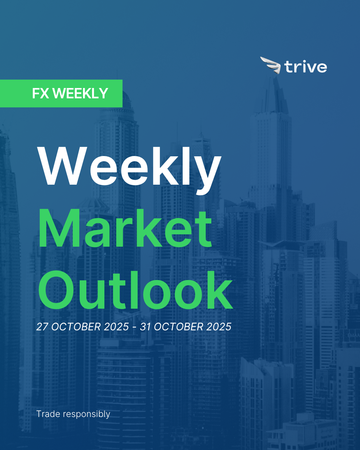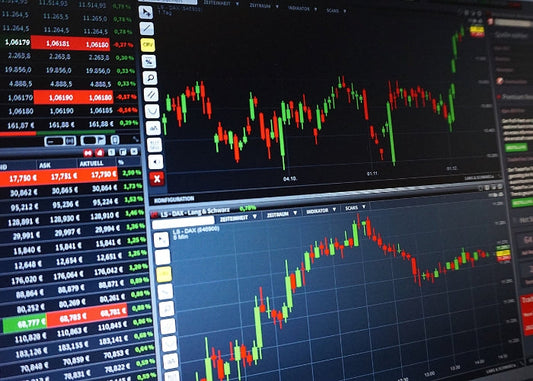FX Daily: Trive Bullish on EUR/USD

The euro recovered strongly last week after initial weakness from France’s downgrade, supported by resilient German and Eurozone PMIs that signaled underlying strength in the bloc’s core economy. ECB officials reiterated that policy is appropriately restrictive, keeping near-term rate cuts off the table. Meanwhile, softer US CPI and a stabilizing global tone weighed on the dollar. With the ECB holding steady and the Fed nearing easing, relative policy momentum now favors the euro.
EUR: Short term strength
The Euro spent most of the week reacting to broader market forces, caught between renewed worries about French sovereign credit and the European Central Bank’s firm “on hold” stance. The currency started the week under pressure after S&P unexpectedly downgraded France’s credit rating, which kept EUR/USD struggling to stay above 1.17. Consistent ECB communication reinforced the message that policy is appropriately restrictive and that no changes are expected in the near term.
Momentum shifted on Friday after the release of mixed October Flash PMI data. While France continued to show weakness, Germany and the broader Eurozone surprised to the upside, signaling resilience in the bloc’s core economy. This led to a rally in the Euro, lifting EUR/USD toward 1.1650 and ending the week on a stronger note.
The key economic event was the release of Flash PMIs, which sharply changed the Eurozone growth outlook. The French Composite PMI fell to 46.8, but the German Composite surged to 53.8, beating expectations of 51.5, supported by a strong Services PMI at 54.5. The overall Eurozone Composite also came in higher at 52.2, suggesting momentum heading into Q4. Other data, including German Producer Prices, were slightly weaker at -0.1% month-on-month but had little market impact.
ECB officials maintained a consistent message that rates are at a neutral level and policy should remain unchanged. Bundesbank President Nagel and Vice President de Guindos both described the current stance as adequate. However, internal differences remained visible. Hawkish member Kazaks said the next move could be either a hike or a cut, while others leaned toward the likelihood of an eventual rate reduction. Market pricing reflected near unanimity, with a 98.4% probability of no change at the upcoming meeting.
Concerns over French debt dominated sovereign headlines. The downgrade of France’s rating to A+ from AA- initially widened the OAT-Bund yield spread. Some relief came mid-week after reports that major asset managers like BlackRock and State Street stopped using benchmarks limited to AA-rated bonds, allowing continued exposure to French debt. However, the reprieve was short-lived, and spreads widened again toward 83 basis points as markets awaited Moody’s next review.
On the geopolitical front, the EU continued to navigate between major global powers. Trade Commissioner Šefčovič spoke with his Chinese counterpart, and Germany planned to raise concerns over China’s export restrictions. President Macron urged the EU to deploy its anti-coercion tools to counter China’s influence. Meanwhile, discussions about support for Ukraine exposed internal divisions. President Zelensky’s planned meeting with EU leaders coincided with disagreements over using frozen Russian assets to fund aid for Kyiv, with Belgium voicing opposition.
The euro started the week under pressure after S&P unexpectedly cut France’s sovereign rating to A plus from AA minus, which widened French spreads versus Germany and briefly weighed on sentiment toward the bloc. As the week went on, stronger German and Eurozone Flash PMIs and steady ECB messaging that policy is already sufficiently restrictive helped restore confidence, and the euro recovered into Friday on firmer footing.
Near term, weak bullish. The main driver is the mix of relative policy support and a stabilising global tone. The ECB is signalling a hold rather than rushing to cut, while US policy is still seen as heading toward easing, which keeps front end euro yields comparatively anchored. German Composite PMI at 53.8 and Eurozone Composite at 52.2 suggest that the core of the bloc is not rolling over, even though France remains weak with a 46.8 Composite. The confirmation of upcoming high level US–China talks has supported risk appetite and limited follow through euro selling despite France’s downgrade. If this week’s ECB meeting reiterates “on hold” and German business surveys like Ifo do not collapse, the euro can stay supported on dips and we keep a weak bullish stance. If tariff rhetoric flips back toward escalation and sovereignty risk in the euro area resurfaces through wider OAT–Bund or BTP–Bund spreads, we would downgrade toward neutral.
Longer term, weak bullish. The medium run bias remains mildly constructive, but with an important caveat. Relative policy still leans in the euro’s favour because the ECB is signalling patience while the Fed is closer to easing. At the same time, the bloc’s external position is healthier than during the 2022 energy shock, which helps the euro’s structural case. The caveat is that France is now rated A plus, and the OAT–Bund spread re-widened as markets questioned fiscal credibility and political stability. That means fragmentation risk is not gone, only controlled for now. If spreads in France and Italy stabilise and services activity continues to hold up, gradual euro appreciation versus a still policy uncertain dollar remains the base case. If spreads lurch wider again or the ECB hints at earlier cuts, we would move this stance back toward neutral.
USD: Short at rally
The US Dollar traded in a choppy and mostly directionless range, with the DXY ending the week little changed despite rising geopolitical tensions and a key US inflation report. The week began quietly as the Dollar consolidated while markets digested President Trump’s softer stance on China. Mid-week, sentiment improved as the unwinding of the “currency debasement” trade led to a sharp decline in gold prices, and solid earnings from Zions Bancorp eased concerns about US regional banks.
On Thursday, the narrative shifted as the US imposed sanctions on major Russian oil companies, triggering a rally in crude oil and dominating the geopolitical landscape. The week ended with the September CPI report, which came in cooler than expected. This initially pressured the Dollar, pushing the DXY to a low near 98.72, but the move was offset by strong Flash PMI data. The surprise termination of trade talks with Canada added volatility, leaving the Dollar caught between dovish inflation data, solid growth signals, and a tense geopolitical environment.
The main driver of the week was the September CPI, which rose 0.3% month-on-month versus expectations of 0.4%, while Core CPI increased 0.2% against 0.3% expected. The yearly Core CPI also undershot at 3.0% compared to 3.1% forecasted, showing that inflation pressures remain contained and supporting the Fed’s easing outlook. In contrast, Flash PMIs were strong, with the Composite PMI at 54.8 and both Manufacturing and Services beating expectations, pointing to solid Q4 growth. Other data were limited due to the ongoing government shutdown, though existing home sales rose 1.5%.
The Fed remained in its blackout period, providing no new commentary, and market pricing for a 25bps cut at the October 30 meeting stayed unchanged.
On the geopolitical side, the US sanctioned Russian energy firms Rosneft and Lukoil, which sent oil prices higher and led to reports that China and India paused seaborne Russian oil imports. Meanwhile, US-China relations stayed mixed, with Washington considering new export controls in response to China’s rare earth policies, though high-level talks in Malaysia and a Trump–Xi meeting were confirmed for the following week. Late in the week, President Trump abruptly ended trade talks with Canada after criticizing a Canadian advertisement, souring North American trade relations. The unresolved US government shutdown continued to add policy uncertainty.
Market sentiment was mixed. Optimism returned early in the week as Zions Bancorp’s results suggested that credit stress was contained. The record plunge in gold prices supported the Dollar mid-week, reflecting a strong reversal of the “weak-dollar” narrative. By Friday, traders were torn between dovish signals from CPI and the growth resilience implied by strong PMI data, leaving the Dollar’s direction uncertain.
The US Dollar advanced this week, ending higher as strong US data, firmer oil prices, and persistent geopolitical tension outweighed a softer CPI print. Early weakness after the inflation report was quickly reversed as markets pared back aggressive Fed easing bets and risk appetite improved on US–China trade optimism. By Friday, the DXY had gained ground, supported by higher real yields and safe-haven demand tied to new sanctions headlines.
Near term, neutral with a bearish skew. The Dollar’s tone has turned more balanced. While September CPI confirmed that inflation pressures are cooling, the upside surprise in PMIs and steady consumption data showed that the US economy remains resilient. That combination reduced the urgency for rate cuts and allowed front end yields to edge higher, lending the Dollar support. Global sentiment has also stabilized, with optimism around renewed US–China talks limiting defensive demand for the yen and franc but lifting the greenback. The Fed is expected to lower the rates this week, and Powell’s tone will determine whether the next leg is higher or lower. A cautious message acknowledging softer inflation but firm growth would keep the Dollar rangebound. Only a distinctly dovish signal, such as explicit guidance toward more cuts would weaken it meaningfully, while a hawkish surprise could quickly lift the bias to bullish. However, if the trade war unexpectedly escalates again, worsening global growth prospects, the Dollar’s outlook would likely deteriorate as confidence and capital flows shift away from US assets.
Longer term, weak bearish. The structural outlook still favors gradual Dollar underperformance as US exceptionalism fades. The Fed remains closer to an easing cycle than its peers, and the accumulation of trade, fiscal, and credit risks continues to weigh on long-term confidence in US assets. Narrowing rate differentials, slower growth momentum, and uncertainty surrounding tariff policy and government funding suggest less room for the Dollar to sustain its strength. However, the path lower is likely to be uneven, given solid near-term growth and the currency’s reserve status.
 EUR/USD 4H
EUR/USD 4H
Disclaimer
This material is provided for informational purposes only and does not constitute financial, investment, or other advice. The opinions expressed in this material are those of the author and do not necessarily reflect the views of Trive International. No opinion contained in this material constitutes a recommendation by Trive International or its author regarding any particular investment, transaction, or investment strategy. This material should not be relied upon in making any investment decision.
The information provided does not consider the individual investment objectives, financial situation, or needs of any specific investor. Investors should seek independent financial advice tailored to their individual circumstances before making any investment decisions. Trive International shall not be liable for any loss, damage, or injury arising directly or indirectly from the use of this information or from any action or decision taken as a result of using this material.
Trive International may or may not have a financial interest in the companies or securities mentioned. The value of investments may fluctuate, and investors may not get back the amount they originally invested. Past performance is not indicative of future results.
For more information about Trive International, please visit http://trive.com/int
Additional Information
Investing involves risk, including the potential loss of principal. Diversification and asset allocation strategies do not ensure a profit or guarantee against loss. The content in this material is subject to change without notice and may become outdated or inaccurate over time. Trive International does not undertake any obligation to update the information in this material.
By accessing this material, you acknowledge and agree to the terms of this disclaimer. If you do not agree with these terms, please refrain from using this information.
कोई टिप्पणी नहीं
Home
Trive
TriveHub




0 टिप्पणियाँ